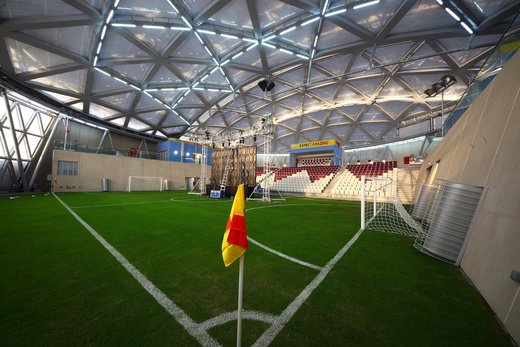18 September 2013
As FIFA decides whether to move the 2022 World Cup to the winter months to avoid excessive heat, Ayshe Ismail revisits how Qatar convinced the FIFA delegation three years ago that its stadia would be cool enough – thanks to some very clever engineering and materials
A serious diplomatic incident in the world of international football erupted last week when FIFA president Sepp Blatter appeared to suggest that it had been a mistake to let Qatar host the 2022 World Cup because it would be just too hot.
Qatar won the bid in 2010, becoming the first Middle Eastern country ever to do so.
But then Mr Blatter said he’d been misquoted and that the “mistake” he had meant was scheduling the tournament for the summer, as is the norm, and not winter.
FIFA’s medical chief Michel D’Hooghe backed him up, saying that holding the tournament in a place where summer temperatures can reach 50°C posed a risk to the health of supporters and players.
Dr D’Hooghe said he would push for the competition to be moved to the winter months at the next executive committee meeting scheduled for October.

Qatar’s prototype mini-stadium, with a cooling system designed by Arup, convinced FIFA that players and fans would not overheat (Arup)
But a winter World Cup would cause major disruption to most European leagues, and be an insult to the Qataris, who say everything will be fine.
There is “no reason” why Qatar should not host the event – as planned – insisted Hassan al-Thawadi, head of the Qatar 2022 organising body.
“We’ve worked very, very hard to ensure we’re within the rules of the bidding, within the rules of the hosting agreement,” he told BBC Sport. “At the same time, we’re delivering on all the promises that we’ve made.”
Why this issue has come to the boil again is unclear, but it’s worth revisiting why Qatar is so confident, and how it impressed the FIFA delegation in the first place with its plans to deploy clever engineering and the magic of phase change materials (PCMs) to keep fans and players cool – without resorting to gargantuan, power-hungry air conditioners.
It was demonstrated to the FIFA delegation using a miniature, prototype, 500-seat stadium designed by Arup, who found a way of using PCMs, and the desert country’s hot climate, to Qatar’s advantage.
Altered states
Phase change materials (PCMs) change state – from solid to liquid and back again, for instance -Â at temperatures humans can handle, and in the process they absorb and give off great quantities of thermal energy.
Here’s how they helped in the prototype stadium.

Inside Qatar’s prototype mini-stadium (Arup)
Nearby, a solar farm focuses the sun’s rays onto a glass tube filled with water, using mirrors. The water is heated up to 200°C (without turning to steam) and then pumped into an absorption chiller to be cooled to 6°C.
This happens during the day and phase change materials are used to store the chiller’s output until it is needed in the evening.
Buried next to the stadium is a tank packed with thousands of plastic blocks containing a PCM developed to freeze at 6°C. During the day the chilled water is piped to the tank, freezing the blocks.
When a match is underway in the evening, the blocks “melt”, releasing coolness down into the stadium via an air-handling unit.
The system can store enough energy to provide cooling for five hours, plenty of time for a football match – even one needing extra-time and a penalty shootout.
As reported in Construction Research & Innovation (CIOB, Vol 2, Issue 3, 2011), when a delegation from FIFA strolled onto the pitch, even though the temperature was a scorching 44°C outside, on the grass it was a pleasant 23°C.
“This zero carbon, environmentally friendly mini-stadium demonstrates that it is possible to provide comfort for football matches in the heat of the desert,” said head of building services at Arup Associates, Mike Beavan.
The system impressed the FIFA delegation three years ago, but whether it will see its full potential tested in 2022 will be decided when the FIFA committee meets next month.










